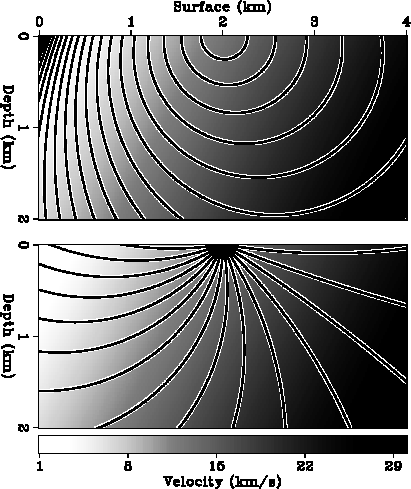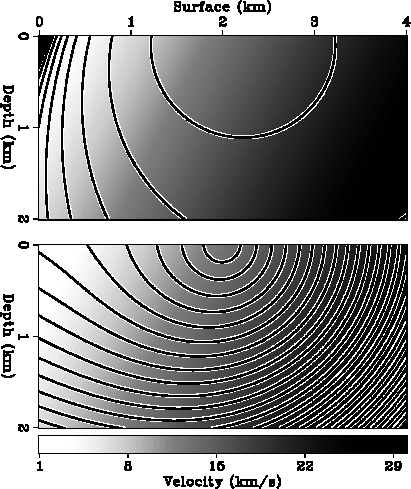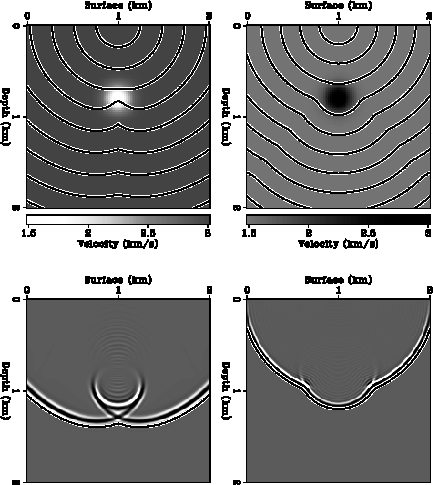




Next: Multiple arrivals
Up: NUMERICAL RESULTS
Previous: NUMERICAL RESULTS
I examine the accuracy of the local ray-tracing method
with three synthetic velocity models.
The first one is a constant gradient velocity model shown
in Figure ![[*]](http://sepwww.stanford.edu/latex2html/cross_ref_motif.gif) . The velocity is 1. km/s at the upper-left corner
of the model. The magnitude of the velocity gradient is 6.56 1/s, and
the direction is 70 degrees to the right of the depth axis.
The velocity at the lower right corner of the model is 30. km/s.
I use the local ray-tracing method to compute the attributes of wavefronts
in this model. The grid size of the computation is 20 meters.
Because the analytical solutions of the wavefronts attributes
are known for such a medium, I plot the contours of the wavefront attributes
calculated by the local ray-tracing method on the top of the
contour plots of the corresponding analytical solutions.
Figure
. The velocity is 1. km/s at the upper-left corner
of the model. The magnitude of the velocity gradient is 6.56 1/s, and
the direction is 70 degrees to the right of the depth axis.
The velocity at the lower right corner of the model is 30. km/s.
I use the local ray-tracing method to compute the attributes of wavefronts
in this model. The grid size of the computation is 20 meters.
Because the analytical solutions of the wavefronts attributes
are known for such a medium, I plot the contours of the wavefront attributes
calculated by the local ray-tracing method on the top of the
contour plots of the corresponding analytical solutions.
Figure ![[*]](http://sepwww.stanford.edu/latex2html/cross_ref_motif.gif) displays the contours of the traveltime
and take-off angle fields.
The contour intervals are 0.02 second for
the traveltime field and 11.4 degrees for the take-off angle field.
The contours of the traveltime and take-off angle fields
show the trajectories of the wavefronts and rays, respectively.
Because of the presence of the velocity gradient, the wavefronts
are stretched in the direction of the velocity gradient and the rays
are bended in the opposite direction of the velocity gradient.
Figure
displays the contours of the traveltime
and take-off angle fields.
The contour intervals are 0.02 second for
the traveltime field and 11.4 degrees for the take-off angle field.
The contours of the traveltime and take-off angle fields
show the trajectories of the wavefronts and rays, respectively.
Because of the presence of the velocity gradient, the wavefronts
are stretched in the direction of the velocity gradient and the rays
are bended in the opposite direction of the velocity gradient.
Figure ![[*]](http://sepwww.stanford.edu/latex2html/cross_ref_motif.gif) displays the contours of the fields of curvature radius
of wavefront and geometrical spreading factor.
The contour intervals are 0.4 km for
the curvature radius field and 0.2 km for the geometrical
spreading factor field.
For a constant velocity model, these two fields are identical.
The presence of large velocity gradient makes them quite different from
each other. In both Figure
displays the contours of the fields of curvature radius
of wavefront and geometrical spreading factor.
The contour intervals are 0.4 km for
the curvature radius field and 0.2 km for the geometrical
spreading factor field.
For a constant velocity model, these two fields are identical.
The presence of large velocity gradient makes them quite different from
each other. In both Figure ![[*]](http://sepwww.stanford.edu/latex2html/cross_ref_motif.gif) and Figure
and Figure ![[*]](http://sepwww.stanford.edu/latex2html/cross_ref_motif.gif) ,
the analytical solutions are plotted
with white fat lines and the results of the local ray-tracing method
are plotted with black thin lines. The near perfect match of two sets of
contour lines indicates the high accuracy of the local-ray tracing
method.
,
the analytical solutions are plotted
with white fat lines and the results of the local ray-tracing method
are plotted with black thin lines. The near perfect match of two sets of
contour lines indicates the high accuracy of the local-ray tracing
method.
ttmthgra
Figure 13 The wavefronts and rays in a linearly varying velocity model.
The backgrounds of the two panels show the velocity field. The source is
positioned at the top center of the model. The top panel shows the contour
lines of the traveltime field with 0.02 second intervals.
The bottom panel shows the contour lines of
the take-off angle field with 11.4 degree intervals.
The white lines shows the analytical solutions and
the black lines show the results of the local
ray-tracing method.
 rjjgra
rjjgra
Figure 14 The curvature radii of wavefronts and geometrical spreading factors
in a linearly varying velocity model.
The backgrounds of the two panels show the velocity field. The source is
positioned at the top center of the model. The top panel shows the contour
lines of the curvature radius field with 0.4 km intervals.
The bottom panel shows the contour lines of
the geometrical spreading factor field with 0.2 km intervals.
The white lines shows the analytical solutions and
the black lines show the results of the local
ray-tracing method.

The second synthetic velocity model is a constant velocity field
with a 50% negative Gaussian anomaly, and the third one with
a 100% positive Gaussian anomaly, as shown in Figure twpn.
The size of anomalies is
about 200 meters. I use the local ray-tracing method to compute
the traveltime field of first arrivals in these models.
The grid size used in the computations is 20 meters.
In Figure ![[*]](http://sepwww.stanford.edu/latex2html/cross_ref_motif.gif) , I compare the results of the traveltime calculations
with the wave fields simulated by wave-equation modeling.
Because a minimum phase wavelet is used in the wave-equation modeling,
the contour lines of the traveltime fields closely follow the first
breaks of the wavelets in the corresponding
snapshots of the wave fields.
, I compare the results of the traveltime calculations
with the wave fields simulated by wave-equation modeling.
Because a minimum phase wavelet is used in the wave-equation modeling,
the contour lines of the traveltime fields closely follow the first
breaks of the wavelets in the corresponding
snapshots of the wave fields.
twpn
Figure 15 The wavefronts of first arrivals in velocity models with a negative
Gaussian anomaly (left) and a positive anomaly (right).
The backgrounds of the top panels show the velocity fields.
Overlain are the contour lines of the traveltime fields.
The contour interval is 0.08 second for the left panel and 0.14 for
the right panel.
The bottom panel compares the wave fields simulated by wave-equation modeling
with the traveltime field calculated by the local ray-tracing method.
The intensity plots show snapshots of the wave fields at 0.48 second (left)
and 0.7 second (right); the overlain curves are
the 0.48s-contour line (left)
and 0.7s-contour line (right) of the traveltime fields.






Next: Multiple arrivals
Up: NUMERICAL RESULTS
Previous: NUMERICAL RESULTS
Stanford Exploration Project
11/17/1997
![[*]](http://sepwww.stanford.edu/latex2html/cross_ref_motif.gif) . The velocity is 1. km/s at the upper-left corner
of the model. The magnitude of the velocity gradient is 6.56 1/s, and
the direction is 70 degrees to the right of the depth axis.
The velocity at the lower right corner of the model is 30. km/s.
I use the local ray-tracing method to compute the attributes of wavefronts
in this model. The grid size of the computation is 20 meters.
Because the analytical solutions of the wavefronts attributes
are known for such a medium, I plot the contours of the wavefront attributes
calculated by the local ray-tracing method on the top of the
contour plots of the corresponding analytical solutions.
Figure
. The velocity is 1. km/s at the upper-left corner
of the model. The magnitude of the velocity gradient is 6.56 1/s, and
the direction is 70 degrees to the right of the depth axis.
The velocity at the lower right corner of the model is 30. km/s.
I use the local ray-tracing method to compute the attributes of wavefronts
in this model. The grid size of the computation is 20 meters.
Because the analytical solutions of the wavefronts attributes
are known for such a medium, I plot the contours of the wavefront attributes
calculated by the local ray-tracing method on the top of the
contour plots of the corresponding analytical solutions.
Figure ![[*]](http://sepwww.stanford.edu/latex2html/cross_ref_motif.gif) displays the contours of the traveltime
and take-off angle fields.
The contour intervals are 0.02 second for
the traveltime field and 11.4 degrees for the take-off angle field.
The contours of the traveltime and take-off angle fields
show the trajectories of the wavefronts and rays, respectively.
Because of the presence of the velocity gradient, the wavefronts
are stretched in the direction of the velocity gradient and the rays
are bended in the opposite direction of the velocity gradient.
Figure
displays the contours of the traveltime
and take-off angle fields.
The contour intervals are 0.02 second for
the traveltime field and 11.4 degrees for the take-off angle field.
The contours of the traveltime and take-off angle fields
show the trajectories of the wavefronts and rays, respectively.
Because of the presence of the velocity gradient, the wavefronts
are stretched in the direction of the velocity gradient and the rays
are bended in the opposite direction of the velocity gradient.
Figure ![[*]](http://sepwww.stanford.edu/latex2html/cross_ref_motif.gif) displays the contours of the fields of curvature radius
of wavefront and geometrical spreading factor.
The contour intervals are 0.4 km for
the curvature radius field and 0.2 km for the geometrical
spreading factor field.
For a constant velocity model, these two fields are identical.
The presence of large velocity gradient makes them quite different from
each other. In both Figure
displays the contours of the fields of curvature radius
of wavefront and geometrical spreading factor.
The contour intervals are 0.4 km for
the curvature radius field and 0.2 km for the geometrical
spreading factor field.
For a constant velocity model, these two fields are identical.
The presence of large velocity gradient makes them quite different from
each other. In both Figure ![[*]](http://sepwww.stanford.edu/latex2html/cross_ref_motif.gif) and Figure
and Figure ![[*]](http://sepwww.stanford.edu/latex2html/cross_ref_motif.gif) ,
the analytical solutions are plotted
with white fat lines and the results of the local ray-tracing method
are plotted with black thin lines. The near perfect match of two sets of
contour lines indicates the high accuracy of the local-ray tracing
method.
,
the analytical solutions are plotted
with white fat lines and the results of the local ray-tracing method
are plotted with black thin lines. The near perfect match of two sets of
contour lines indicates the high accuracy of the local-ray tracing
method.


